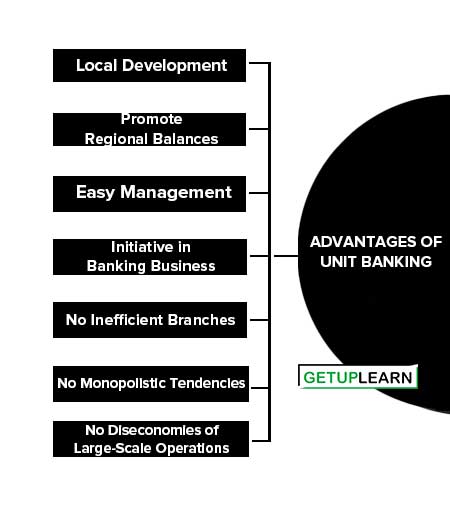Table of Contents
What are Banking Systems?
The banking systems in different countries vary substantially from one another. The banking system of a country depends on the economic, and political conditions of the country and also on the traditions of the people.
Various banking systems existed are Branch Banking, Unit Banking, Group Banking, Correspondent Banking, Chain Banking, Deposit Banking, Investment Banking, and Mixed Banking. However, of all the above Unit Banking and Branch Banking are the two important systems.
What is Branch Banking?
Under the Branch Banking system, a big bank is a single institution and under single ownership operates through a network of branches spread all over the country. Initially, branch banking is developed in England. Later on, it became popular in other countries like Canada, Australia, India etc.
In England, most of the banking business is in the hands of five big banks i.e., the Midland, the Lloyds, the Barclays, the Westminister, and the National Provincial. In terms of branches, the State Bank of India has emerged as one of the biggest banks.
Advantages of Branch Banking
Rapid Growth and Wide popularity of the branch banking system in the 20th century are due to various advantages of branch banking as discussed below:
- Economies of Large-Scale Operations
- Spreading of Risk
- Economy in Cash Reserves
- Cheap Remittance Facilities
- Uniform Interest Rates
- Proper Use of Capital
- Better Facilities for Customers
- Banking Facilities in Backward Areas
- Effective Control
Economies of Large-Scale Operations
Under the branch banking system the bank with a number of branches possesses huge financial resources and enjoys the benefits of large-scale operations:
- Highly trained and experienced staff is appointed which increases the efficiency of management.
- Division of labor is introduced in the banking operations which ensures a greater economy in the working of the bank. Right persons are appointed at the right place and specialization increases.
- Funds are made available liberally and at cheaper rates.
- Foreign exchange is done economically.
- Large financial resources and wider geographical coverage increases public confidence in the banking system.
Spreading of Risk
Another advantage of a branch banking system is the lesser risk and greater capacity to meet risk.
- Since there is geographical spreading and diversification of risk, the possibility of the failure of the bank is remote.
- The losses incurred by some branches may be offset by the profits earned by other branches.
- Large resources of branch banks increase their ability to face any crisis.
Economy in Cash Reserves
Under the branch banking system, a particular branch can operate without keeping large amounts of idle reserves. In times of need, resources can be transferred from one branch to another.
Diversification of Deposits and Assets
There is greater diversification of both deposits and assets under the branch banking system because of wider geographical coverage.
- Deposits are received from the areas where savings are in plenty.
- Loans are extended in those areas where funds are scarce and interest rates are high. The choice of securities and investments is larger in this system which increases the safety and liquidity of funds.
Cheap Remittance Facilities
Since bank branches are spread over the whole country, it is easier and cheaper to transfer funds from one place to another. Inter-branch indebtedness is more easily adjusted than inter-bank indebtedness.
Uniform Interest Rates
Under a branch banking system, the mobility of capital increases and in turn brings about equality in interest rates. Funds are transferred from areas with deficit demand for money to areas with excessive demand for money. As a result, the uniform rate of interest prevails in the whole area.
Proper Use of Capital
Under a branch banking system, capital can be used properly. If a branch has ex- cess reserves, but has no opportunity for investment, it can transfer the resources to other branches which can make the most profitable use of these resources.
Better Facilities for Customers
Under the branch banking system, the customers are getting better and greater facilities. It is because of the small number of customers per branch and increased efficiency achieved through large-scale operations.
Banking Facilities in Backward Areas
Under the branch banking system, the banking facilities are not restricted to big cities. They can be extended to small towns and rural as well as underdeveloped areas. Thus, this system helps in the development of backward regions of the country.
Effective Control
Under the branch banking system, the Central Bank can have more efficient control over the banks, because it has to deal only with a few big banks and not with each individual branch. This ensures better implementation of monetary policy.
Disadvantages of Branch Banking
The following are the main limitations or disadvantages of branch banking system:
- Problem of Management
- Lack of Initiative
- Monopolistic Tendencies
- Regional Imbalances
- Adverse Linkage Effect
- Inefficient Branches
- Other Defects

Problem of Management
Under the branch banking system, a number of difficulties arise with regard to management, supervision, and control. They are:
- Management of banks is concentrated at the head office, the managers can afford to be lax and indulgent in their duties and are often involved in serious irregularities while using the funds.
- Branch Manager has to seek permission from the head office on each and every matter, this results in unnecessary delay and red-tapism in the banking business.
Lack of Initiative
Branch managers generally lack initiative in taking decisions on all important matters. They can not take independent decisions and have to wait for the clearance signal from the head office.
Monopolistic Tendencies
Branch Banking encourages monopolistic tendencies in the banking system. A few big banks dominate and control the whole banking system of the Country through their branches. This can lead to the concentration of resources in a few hands.
Regional Imbalances
Under the branch banking system, the financial resources collected in the smaller and backward regions are transferred to the bigger industrial centers. This encourages regional imbalances in the Country.
Adverse Linkage Effect
Under a branch banking system, the losses and weaknesses of some branches have an effect on the other branches of the bank.
Inefficient Branches
In this system, the weak and unprofitable branches continue to operate under the protection cover of the large and more profitable branches.
Other Defects
Other defects of branch banking are:
- Preferential treatment is given to the branches near the head office.
- Higher interest rates are charged in the developed area to compensate for the lower rates charged in the backward areas.
- There is concentration and unhealthy competition among the branches of different banks in big cities.
- Many difficulties are faced when a bank opens branches in foreign countries.
FAQs About the Branch Banking
What are the advantages of branch banking?
The advantages of branch banking are:
1. Economies of Large-Scale Operations
2. Spreading of Risk
3. Economy in Cash Reserves
4. Cheap Remittance Facilities
5. Uniform Interest Rates
6. Proper Use of Capital
7. Better Facilities for Customers
8. Banking Facilities in Backward Areas
9. Effective Control.
What are the disadvantages of branch banking?
The disadvantages of branch banking are:
1. Problem of Management
2. Lack of Initiative
3. Monopolistic Tendencies
4. Regional Imbalances
5. Adverse Linkage Effect
6. Inefficient Branches
7. Other Defects.




